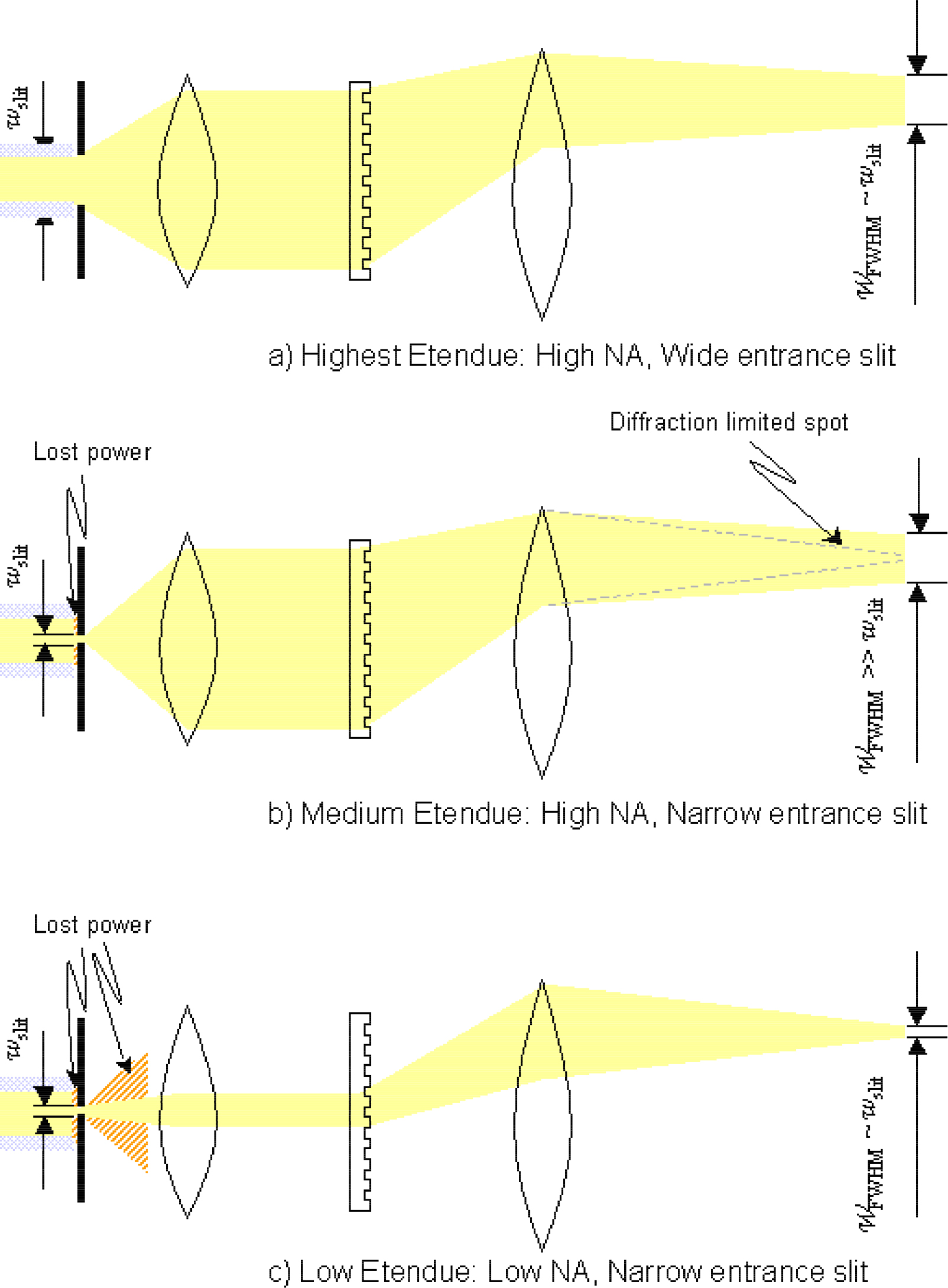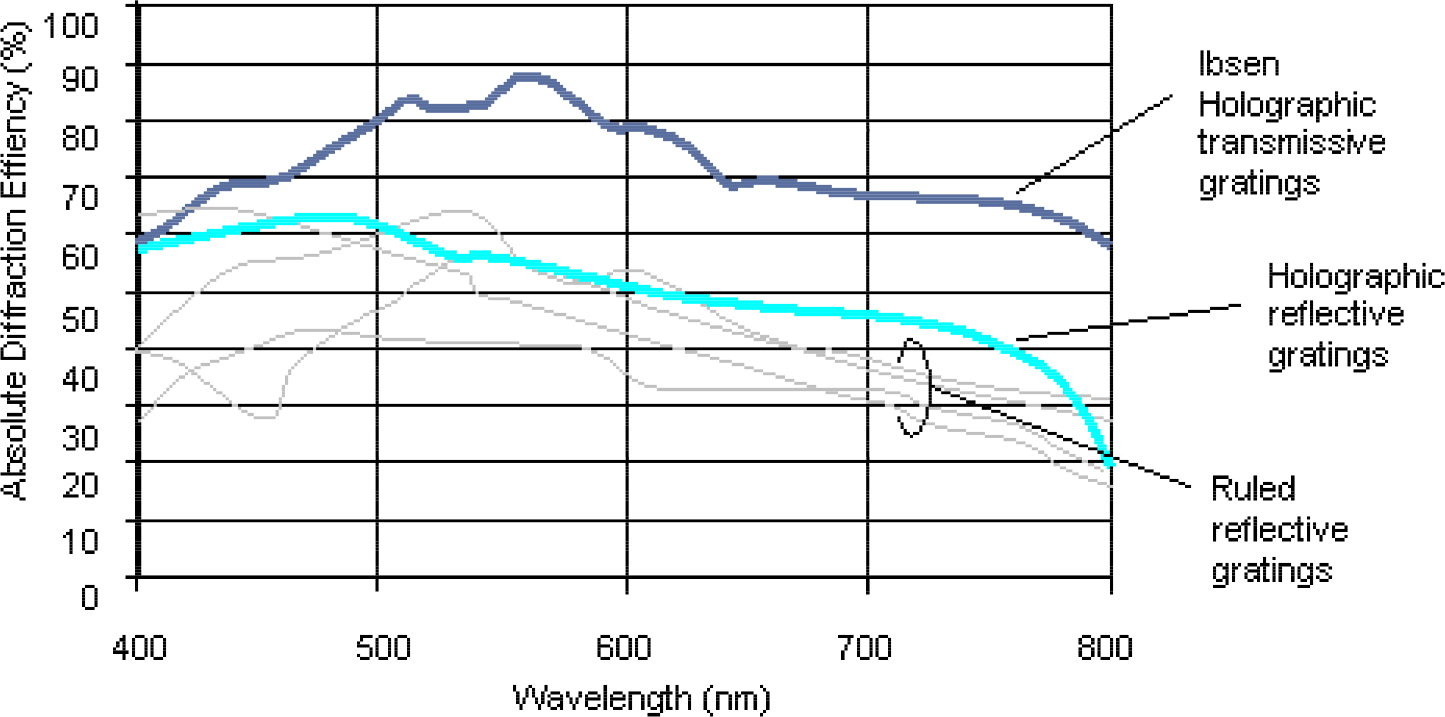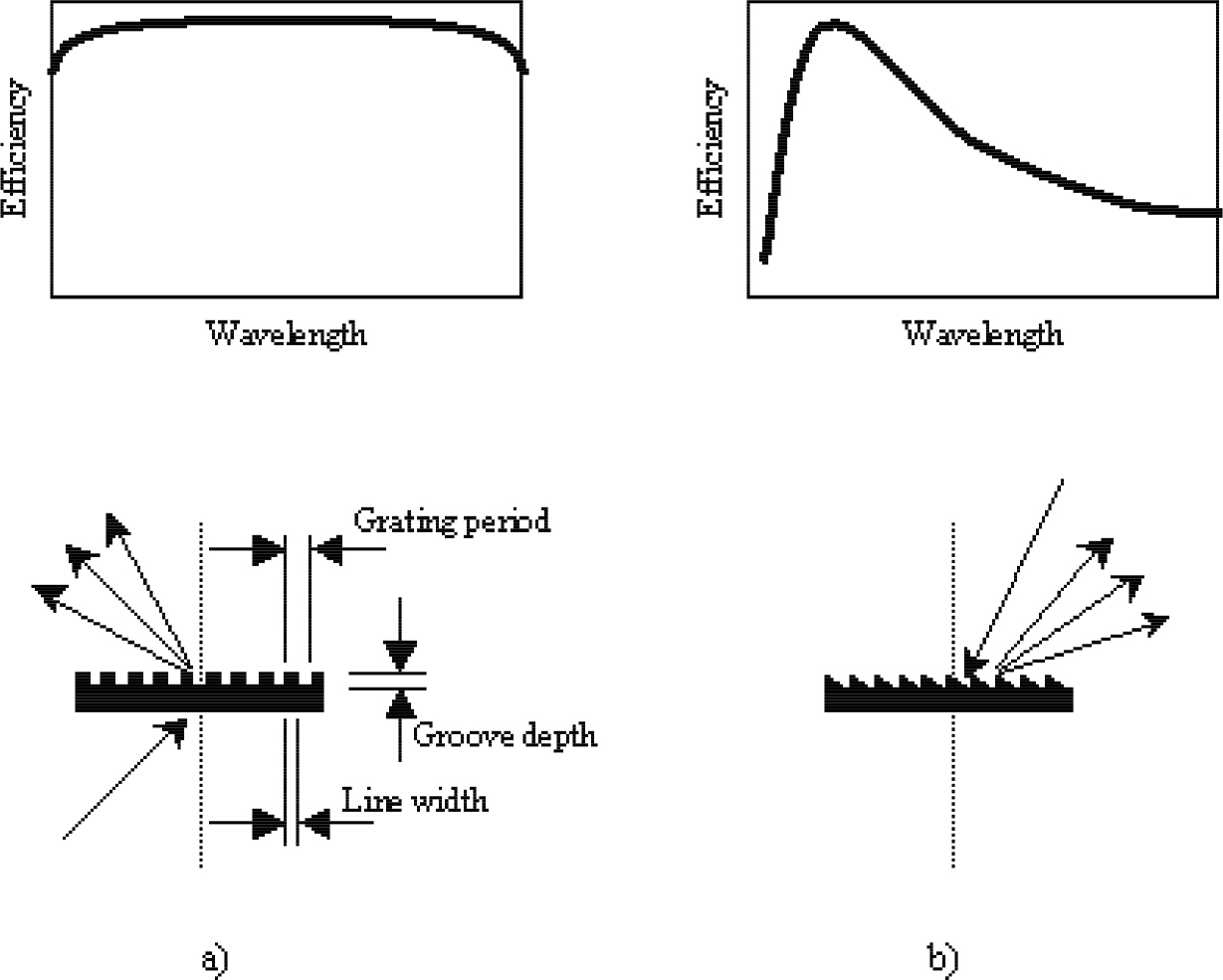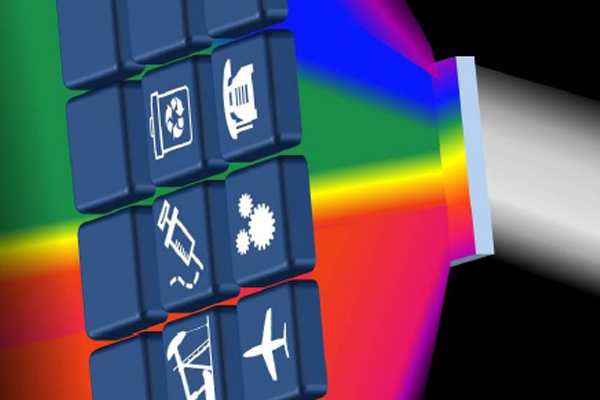Introduction
During the past 15 years compact, low cost spectrometers have grown to a fairly large market size of hundreds of millions of dollars, with applications ranging from medical haemoglobin content analysis over accurate color determination of textiles to sorting of LEDs in large semiconductor manufacturing plants. The majority of these compact spectrometers have been based on the Crossed Czerny- Turner configuration with a reflective diffraction grating as the dispersive element separating the wavelength content onto a linear detector array. The success of this configuration is based on the facts that a) the configuration provides a compact and folded beam path and b) the reflective grating can be mass-produced at relatively low cost. In this white paper I will present two alternative compact spectrometer designs based on transmission gratings rather than reflective gratings and explain the distinct benefits of the transmission grating based geometries
: • A spectrometer design that allows easy access to the detector plane and thereby provides larger flexibility for OEM integrators
. • A higher throughput that enables higher sensitivity, shorter integration time, faster spectral scan, and/or lower light source power consumption
In all fairness, high quality transmission gratings have traditionally been expensive to manufacture and this is probably one of the key reasons that they have not really been considered for compact spectrometer designs. However, recent advances in manufacturing techniques at for instance Ibsen Photonics have led to sales prices in volume of holographically produced, fused silica gratings comparable to reflection gratings. So, combining the attractive benefits with a competive price has led to a renewed interest in transmission grating based compact spectrometer designs.
Spectrometer configurations
Any spectrometer consists of three basic optical components:
- a) collimating optics at the input
- b) a diffraction grating
- c) focusing optics that focus different wavelengths of the spectrum onto different pixels on the detector array
Both the Crossed Czerny-Turner (CCT) and the Transmission Grating based Spectrometer (TGS) include these three elements.
For the TGS, we will consider two basic designs which have slightly different characteristics – the Lens-Grating-Lens (LGL) using two lenses and a grating, and the Mirror-Grating-Mirror (MGM) using two mirrors and a grating.

Figure 1: Spectrometer configurations: a) Crossed Czerny-Turner, b) Lens-Grating-Lens, c) Mirror-Grating-Mirror
Figure 1 shows the CCT, the LGL, and the MGM spectrometer lay-outs and schematic beam paths.
Some words on spectrometer comparison
Before we dive into a comparison of reflection grating based with transmission grating based spectrometers, I would like to mention some important design consideration. The key parameters to consider when specifying (the optical part of) a spectrometer are:
• the wavelength range
- the resolution •
the signal-to-noise ratio and stray light level requirements
- the dynamic range requirements • the linearity requirements
- the power coupling into the spectrometer (Etendue)
- the physical size of the spectrometer
A spectrometer can in general not be optimised for all parameters, so it is important to compare only spectrometers that are designed for the same application.
As an example let us consider why good resolution and high power coupling (Etendue) are opposite design criteria. The Etendue is a measure of how much light can be coupled into a spectrometer and is given by the area of the input slit times the numerical aperture squared.
The resolution is defined as the Full Width at Half Maximum (FWHM) of the peak that the spectrometer measures when the input is a monochromatic light source. The minimum obtainable resolution of a spectrometer is equivalent to the spot size on the detector of a monochromatic point source at the entrance of the spectrometer. This minimum spot size is theoretically determined by the diffraction limited spot size that can be obtained on the detector. However, in most compact spectrometers the minimum spot size is determined by aberrations in the optics inside the spectrometer (the lenses/mirrors and grating). So, in order to obtain a very good resolution the spectrometer should be designed with a near on-axis beam path to reduce aberrations as much as possible. This means that the opening angle of the spectrometer (the numerical aperture) will be very small and the input beam will have to pass through a small slit. Both the low numerical aperture and the small slit means that only a fraction of the input light to the spectrometer will be used as depicted in Figure 2.

Figure 2: Illustration of the relation between Numerical aperture, entrance slit width and resolution for a spectrometer.
In the following we compare spectrometers with the same Etendue (numerical aperture = 0.11 and infinitesimal small slit width) to make sure we compare apples with apples.
Comparison of spectrometer configurations
spectrometer configurations
Table 1 provides a rough comparison of the overall characteristics in terms of resolution, throughput, and detector flexibility for the three spectrometer platforms. The table has been compiled using data from realized Ibsen spectrometers like the ROCK VIS series as well as spectrometer data from for instance Ocean Optics USB4000 and Avantes Avaspec2048. As can be seen, all three platforms provide the same resolution relative to the wavelength range to be covered. This is a consequence of the fact that the sizes of the beams relative to the optical components are roughly the same in all compact spectrometers and therefore the aberrations (determining the minimum resolution) are also roughly the same. Platform Grating type Minimum resolution (NA = 0.11) Througput lst to 2*lst Easy detector access CCT Reflective ~Range/700 ~40 – 60% No LGL Transmission ~Range/700 ~60 – 90% Yes MGM Transmission ~Range/700 ~60 – 90% No Table 1 clearly shows that the LGL and MGM platforms result in the highest throughput as will be further explained in the next section.

Table 1: Comparison of Czerny-Turner with the two transmission grating based width and resolution for a spectrometer.
The choice between the LGL and MGM platforms depends mostly on the following considerations. If high power collection from the sample (high Etendue) is more important than a small resolution, one should consider a high NA spectrometer. This is best obtained with the LGL design since the optics and beam sizes can easily be expanded with-out the risk that beams overlap. On the other hand, if an ultra-small resolution is required and power collection is less important the MGM might prove to be the best option because mirrors tend to be less costly than lenses. Finally, in the UV range the MGM platform may be preferred over the LGL since UV-grade glass can be more expensive than mirrors.
Optical throughput
The key benefit of transmission grating based spectrometers is a higher throughput due to the fact that transmission gratings generally provide higher diffraction efficiency than reflective gratings.

Figure 3: Diffraction efficiency of reflective and transmission gratings
Figure 3 shows a comparison of typically used commercial diffraction gratings for the visible range (400 – 800 nm). As can be seen, the Holographic, fused silica transmission grating provide 50 – 100 % more absolute throughput over the wavelength range than reflective gratings. This difference is a consequence of several factors.
The reflective gratings are coated with a metal coating which can have a reflectance as low as 90%. In contrast transmission gratings are typically etched directly into a pure fused silica substrate and provided with an AR coating on the surface opposite to the grating. Thus, the inherent transmission is very close to 100% since there are no metal coatings and the AR coating can provide more than 98% transmission.
Furthermore, transmission gratings contain more design parameters than reflective gratings. The line shape of a transmission grating can be optimised in both the duty cycle and the etching depth as shown on Figure 4 a). Therefore, a transmission grating can be optimized to high efficiency over a broad wavelength range. In comparison, reflective blazed gratings have only one design parameter – the blaze angle and indicated on Figure 4 b). The grating line profile is determined by the blaze angle and line density and therefore any blazed grating will have almost the same diffraction efficiency as indicated on Figure 4 b). Maximum efficiency is naturally optained at the blaze wavelength (the wavelength the grating was optimized for) but the efficiency falls off quite rapidly especially on the short wavelength tail.

Figure 4: Geometry and typical wavelength dependent 1st order diffraction efficiency for a) transmission grating and b) blazed reflection grating.
Detector size flexibility
From the schematic drawings of the three spectrometer platforms in Figure 1, it is quite obvious that the unfolded LGL platform provides the best flexibility for changing detector since the detector is well separated from the rest of the optical components and beam paths. This actually also goes for other components such as optical filters and apertures that are much easier to fit into the LGL platform than the CCT and MGM.
Temperature stability
The TGS platform uses a transmission grating made from pure fused Silica and is as such useable in a very wide temperature range. Furthermore, fused Silica has a very low thermal expansion coefficient, and therefore the thermal stability of a spectrometer based on such a grating is extremely good.
Application examples
In this section I will highlight some application examples where a transmission grating based spectrometer can provide important benefits. These examples are just meant as appetizers and I am sure you will be able to find many more examples within your own specific application area of interest.
Increasing battery life time for portable spectrometers
Handheld, battery operated spectrometers are becoming quite popular for various applications like fast color checks of textiles or identification of chemicals in the pharma and security industry using Raman spectroscopy. Naturally, one of the key parameters for such devices is the battery life that is determined by the power consumption. By implementing an LGL system with an NA of 0.22 and a fused Silica transmission grating it is easily possible to obtain 4 times higher throughput than traditional CCT spectrometers on the market1. This better sensitivity can be used to lower the power consumption of the light sources in the system.
Increasing productivity for in-line process spectroscopy Many industries are using spectrometers for quality/process control in manufacturing. One example is the LED industry where LEDs are tested on wafer level for their spectral emission properties. Obviously, there is a desire for such processes to run as quickly as possible. For the spectrometer this means running with as short integration times for the detector array as possible. Detector arrays allowing integration times as short as 1 microsecond do exist, but in most cases the detector will not collect enough light in such a short time period to measure anything but noise. However, with a high NA spectrometer using a high throughput transmission grating the integration time can easily be shortened by a factor of 10 – 20 times over traditional spectrometers.
Summary In this white paper I have reviewed two generic, compact spectrometer designs based on transmission diffraction gratings, and described the distinct benefits that such spectrometers have over traditional reflection grating based spectrometers.
In general, transmission grating based spectrometers (TGS) should be considered for spectroscopy applications and instruments where one or more of the following requirements are important
: • Low light levels
- Short integration time / fast spectral scans
- Access to detector for OEM integration
- High thermal stability
With recent developments in grating manufacturing, prices of transmission grating based and reflection grating based compact spectrometers are in the same range. So, the choice of spectrometer platform really has to be done based on technical requirements. Hopefully, this paper has opened your eyes to the fact that the optimum choice for your next spectroscopy platform might very well be a transmission grating based one. 1 Obtained from a direct comparison of the ROCK VIS RSV-300 and Ocean Optics USB2000
About the author Thomas Rasmussen is a Ph.D. in Integrated Optics from the Technical University of Denmark and VP of Business Development, Sales, and Marketing at Ibsen Photonics in Copenhagen, Denmark.







